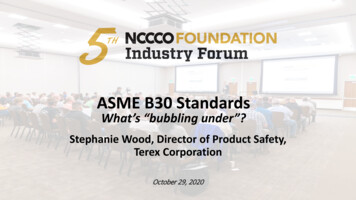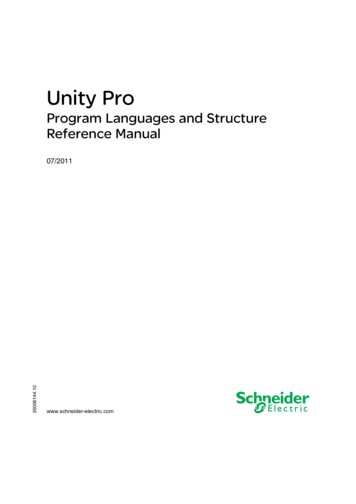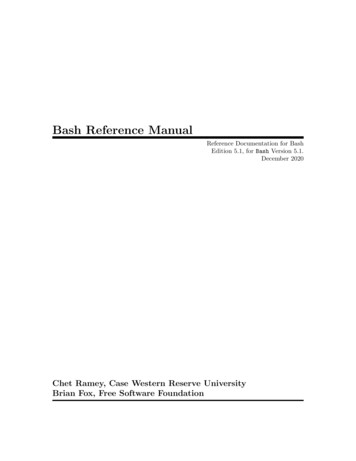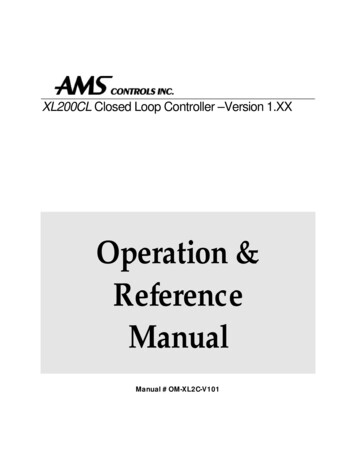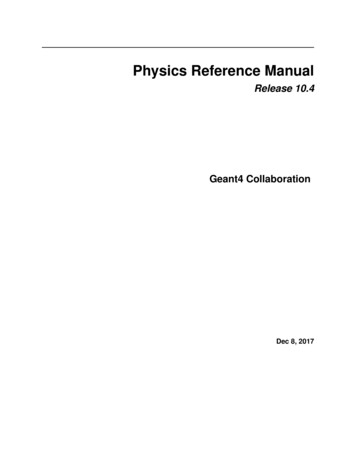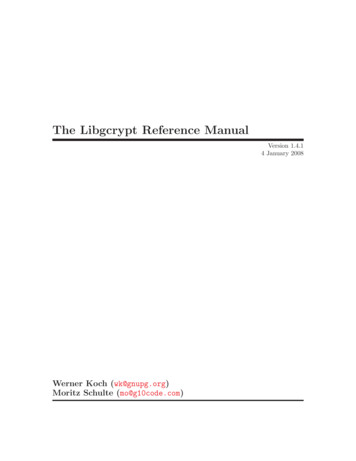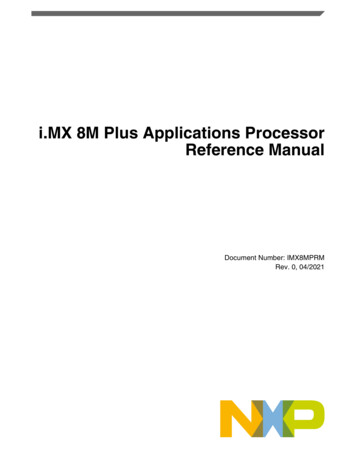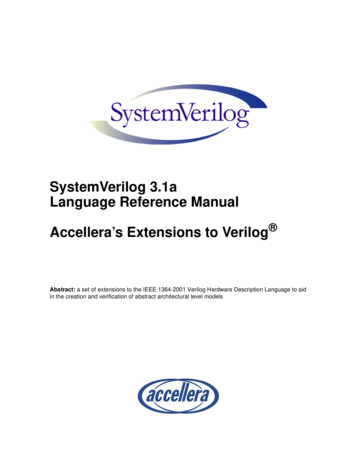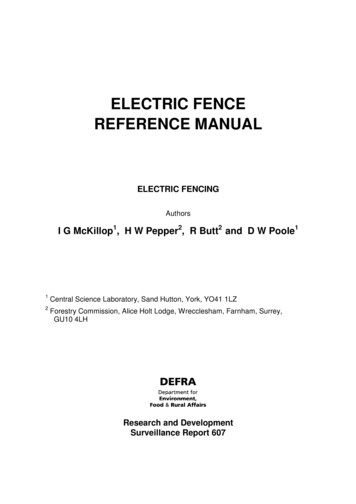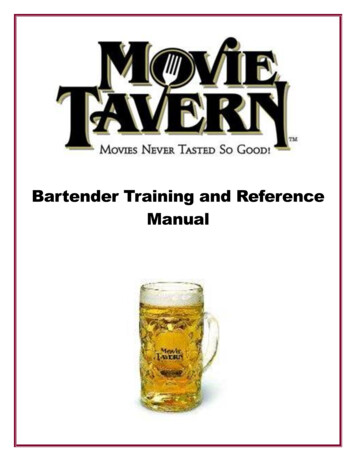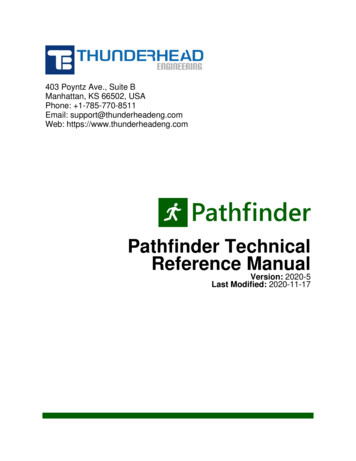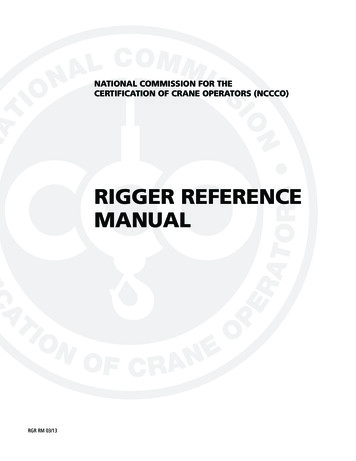
Transcription
NATIONAL COMMISSION FOR THECERTIFICATION OF CRANE OPERATORS (NCCCO)RIGGER REFERENCEMANUALRGR RM 03/13This page intentionally left blank
HOLD HARMLESS/RELEASE/DISCLAIMER AGREEMENTThe reading and/or using person or entities using thispublication for and in consideration of the assistance,cooperation, and information given by the NationalCommission for the Certification of Crane Operators(NCCCO) in this publication, Rigger Reference Manual,the receipt of which is acknowledged, does herebyand for all future time have released, hold harmlessfrom any liability, and forever discharged for itself, itsadministrators and assigns the said NCCCO from alland any manner of action or demands whatsoever inlaw, in admiralty, or in equity, which against the saidNCCCO anyone ever had, now have, or which shallbe later claimed. This agreement relates specificallyto any cause of action arising out of the publication,information provided, subsequent conduct, and anyuse of the information provided in this publicationiiand related uses or demonstrations of skills, methods,and techniques cite in the publication. This mutuallybeneficial release and hold harmless agreement maynot be changed orally, and exists in perpetuity. NCCCOgenerally and specifically disclaims any warranty, merchantability of intended or unintended use or liabilitylifting industry and promote public safety.Copyright 2013 by National Commission for the Certification of Crane Operators. All rights reserved. Nopart of this book may be reproduced or transmitted inany form or by any means, electronic or mechanical,including photocopying, without prior written permission from the publisher. For information, contact thepublisher, National Commission for the Certification ofCrane Operators, Inc.Copyright 2009–2013 National Commission for the Certification of Crane Operators. All rights reserved. RGR RM REV 03/13
PrefaceThis manual has been provided as a reference source for candidates preparing to take theNCCCO Rigger certification exams. NCCCO subject matter experts compiled from a number of sources and selected sections of relevant material for inclusion in the NCCCO RiggerReference Manual. ASME and OSHA granted NCCCO permission for posting and printingselected sections from the following ASME and OSHA standards: ASME B30.5 - Mobile and Locomotive Cranes ASME B30.10 - Hooks ASME B30.20 - Below-the-Hook Lifting Devices OSHA 1910.184 - Slings OSHA 1926.251 - Rigging Equipment for Material Handling OSHA 29 CFR 1926 Subpart CC - Cranes and Derricks in ConstructionPortions reprinted from ASME B30.5, B30.10, ASME B30.20 and ASME B30.23 by permissionof The American Society of Mechanical Engineers. All rights reserved.The following reference materials, in addition to the references cited above, are used byNCCCO’s Examination Committee to verify the accuracy of NCCCO test questions. ASME B30.9 - Slings ASME B30.26 - Rigging Hardware IPT’s Crane and Rigging Training Manual Rigging for Ironworkers Reference Manual NCCCO Rigger Reference BookletThe material contained herein is not to be used for any other purpose than referencematerial in association with preparing for the NCCCO exam. No part of this manual is tobe copied or used in any manner other than by individual candidates preparing for theNCCCO Rigger examination.Copyright 2009–2013 National Commission for the Certification of Crane Operators. All rights reserved. RGR RM REV 03/13iii
This page intentionally left blank
Table of ContentsChapter 1: ASME B30.5-2011 – Mobile and Locomotive Cranes. 1Section 5-3.1.3.2: Responsibilities of Site Supervisor and Lift Director.35-3.1.3.2.1 The site supervisor’s responsibilities shall include the following:.35-3.1.3.2.2 The lift director’s responsibilities shall include the following:.3Chapter 2: ASME B30.10-2009 – Hooks. 5Section 10-1: Selection, Use, and Maintenance.710-1.8: Identification.710-1.10.6 Repairs and Modifications.7Chapter 3: ASME B30.20-2010 – Below the Hook Lifting Devices. 9Section 20-1: Structural and Mechanical Lifting Devices.11Section 20-1.2: Marking, Construction, and Installation.11Section 20-1.3: Inspection, Testing, and Maintenance.11Section 20-1.4: Operation.11Chapter 4: OSHA 1910.184 – Slings. 13Regulations 1910.184.15Chapter 5: OSHA 1926.251 – Rigging Equipment for Material Handling. 25Regulations 1926.251.27§ 1926.251 Rigging Equipment for Material Handling . .27Chapter 6: OSHA 29 CFR 1926, Subpart CC – Cranes and Derricks in Construction. 31Regulations 1926 Subpart CC.33§ 1926.1401 Definitions .33§ 1926.1402 Ground conditions .37§ 1926.1403 Assembly/Disassembly—selection of manufacturer or employer procedures . .38§ 1926.1404 Assembly/Disassembly—general requirements (applies to all assemblyand disassembly operations) . .38§ 1926.1405 Disassembly—additional requirements for dismantling of booms and jibs(applies to both the use of manufacturer procedures and employer procedures) .40§ 1926.1406 Assembly/Disassembly—employer procedures—general requirements .40§ 1926.1407 Power line safety (up to 350 kV)—assembly and disassembly. . .40§ 1926.1408 Power line safety (up to 350 kV)—equipment operations .41§ 1926.1409 Power line safety (over 350 kV) .44§ 1926.1410 Power line safety (all voltages)—equipment operations closer than theTable A zone .44§ 1926.1411 Power line safety—while traveling under or near power lines with no load .46§ 1926.1412 Inspections.46§ 1926.1413 Wire rope—inspection. .49§ 1926.1414 Wire rope—selection and installation criteria. . .51§ 1926.1415 Safety devices. .53§ 1926.1416 Operational aids. . .53Copyright 2009–2013 National Commission for the Certification of Crane Operators. All rights reserved. RGR RM REV 03/13v
§ 1926.1417 Operation. . .55§ 1926.1418 Authority to stop operation. . .57§ 1926.1419 Signals—general requirements. . .57§ 1926.1420 Signals—radio, telephone or other electronic transmission of signals. .58§ 1926.1421 Signals—voice signals— additional requirements. .58§ 1926.1422 Signals—hand signal chart. .58§ 1926.1423 Fall protection. .59§ 1926.1424 Work area control .60§ 1926.1425 Keeping clear of the load .61§ 1926.1425 Keeping clear of the load. .61§ 1926.1426 Free fall and controlled load lowering. . .62§ 1926.1427 Operator qualification and certification. .62§ 1926.1428 Signal person qualifications. .66§ 1926.1429 Qualifications of maintenance & repair employees. .66§ 1926.1430 Training. .67§ 1926.1431 Hoisting personnel .67§ 1926.1432 Multiple-crane/derrick lifts— supplemental requirements . .73§ 1926.1433 Design, construction and testing. . .73§ 1926.1434 Equipment modifications. .76§ 1926.1435 Tower cranes. .77§ 1926.1436 Derricks. .80§ 1926.1437 Floating cranes/derricks and land cranes/derricks on barges. .84§ 1926.1438 Overhead & gantry cranes. . .88§ 1926.1439 Dedicated pile drivers. . .88§ 1926.1440 Sideboom cranes. .88§ 1926.1441 Equipment with a rated hoisting/lifting capacity of 2,000 pounds or less. .89§ 1926.1442 Severability. . .90Appendix A to Subpart CC of Part 1926—Standard Hand Signals.91Chapter 7: Rigger Reference Booklet. 93viCopyright 2009–2013 National Commission for the Certification of Crane Operators. All rights reserved. RGR RM REV 03/13
CHAPTER 1:ASME B30.5-2011 – Mobile andLocomotive CranesSection 5-3.1.3.2: Responsibilitiesof Site Supervisor and Lift DirectorReprinted from ASME B30.5, by permission of the American Societyof Mechanical Engineers. All rights reserved.Copyright 2009–2013 National Commission for the Certification of Crane Operators. All rights reserved. RGR RM REV 03/131
This page intentionally left blank
Section 5-3.1.3.2: Responsibilities of SiteSupervisor and Lift Director5-3.1.3.2 Responsibilities of SiteSupervisor and Lift Director(i) allowing crane operation near electric power linesonly when the requirements of para. 5-3.4.5 havebeen met.5-3.1.3.2.1 The site supervisor’sresponsibilities shall include the following:(j) permitting special lifting operations only whenequipment and procedures required by this Volume,the crane manufacturer, or a qualified person areemployed. Such operations include, but are notlimited to, the following:(a) ensuring that the crane meets the requirements ofChapter 5-2 prior to initial site usage.(b) determining if additional regulations are applicableto crane operations.(1) multiple crane lifts(2) lifting personnel(c) ensuring that a qualified person is designated as thelift director.(3) pick and carry operations(d) ensuring that crane operations are coordinated withother jobsite activities that will be affected by or willaffect lift operations.(e) ensuring that the area for the crane is adequatelyprepared. The preparation includes, but is notlimited to, the following:(1) access roads for the crane and associatedequipment(2) sufficient room to assemble and disassemble thecrane(3) an operating area that is suitable for the cranewith respect to levelness, surface conditions,support capability, proximity to power lines,excavations, slopes, underground utilities,subsurface construction, and obstructions tocrane operation(4) traffic control as necessary to restrictunauthorized access to the crane’s working area(f ) ensuring that work involving the assembly anddisassembly of a crane is supervised by a qualifiedperson.(g) ensuring that crane operators meet therequirements of para. 5-3.1.2.(h) ensuring that conditions that may adversely affectcrane operations are addressed. Such conditionsinclude, but are not limited to, the following:(1) poor soil conditions(2) wind v
ASME B30.10 - Hooks ASME B30.20 - Below-the-Hook Lifting Devices OSHA 1910.184 - Slings OSHA 1926.251 - Rigging Equipment for Material Handling OSHA 29 CFR 1926 Subpart CC - Cranes and Derricks in Construction Portions reprinted from ASME B30.5, B30.10, ASME B30.20 and ASME B30.23 by permission
